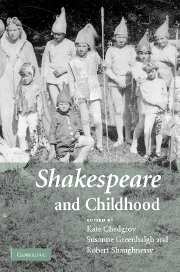Book contents
- Frontmatter
- Contents
- Acknowledgements
- Notes on contributors
- Note on the text
- 1 Introduction
- PART 1 SHAKESPEARE'S CHILDREN
- PART 2 CHILDREN'S SHAKESPEARES
- 8 Introduction: reinventing Shakespearean childhoods
- 9 Play's the thing: agency in children's Shakespeares
- 10 Shakespeare in the Victorian children's periodicals
- 11 Growing up with Shakespeare: the Terry family memoirs
- 12 Shakespeare in the company of boys
- 13 Dream children: staging and screening childhood in A Midsummer Night's Dream
- 14 Shakespeare (')tween media and markets in the 1990s and beyond
- APPENDICES
- Index
13 - Dream children: staging and screening childhood in A Midsummer Night's Dream
Published online by Cambridge University Press: 22 September 2009
- Frontmatter
- Contents
- Acknowledgements
- Notes on contributors
- Note on the text
- 1 Introduction
- PART 1 SHAKESPEARE'S CHILDREN
- PART 2 CHILDREN'S SHAKESPEARES
- 8 Introduction: reinventing Shakespearean childhoods
- 9 Play's the thing: agency in children's Shakespeares
- 10 Shakespeare in the Victorian children's periodicals
- 11 Growing up with Shakespeare: the Terry family memoirs
- 12 Shakespeare in the company of boys
- 13 Dream children: staging and screening childhood in A Midsummer Night's Dream
- 14 Shakespeare (')tween media and markets in the 1990s and beyond
- APPENDICES
- Index
Summary
What does it mean for a child to act or for an audience to watch that performance? Many attempts to answer these questions have focused on the child performers of the early modern stage, the ‘play-boys’ of the adult companies, with all their enticing ambiguities of sexuality and gender, or the highly schooled performers of the children's companies, with their repertoire dominated by comedy and satire. Discussion of the boy players in the adult companies has tended to alternate between their possible impact on the nature of the female roles written for them, and attention to their erotic effect when playing those roles. However, as Lucy Munro argues in chapter 6, juvenile acting out of masculine political authority by the children's companies could take on a subversive force precisely by means of the distance between the young actors' physicality and cultural status and the dramatic roles they played. If the Shakespearean roles created for boys to play only rarely made use of such sharp, satirical disjunctions between the age of the actor and the nature of the part, the child characters and their performers are more than incidental insertions into the narrative, or sentimentalized supernumeraries to the main action. The Shakespearean child has often been viewed as archetypal ‘innocent victim’, on the assumption that the meanings of childhood are themselves stable, and thus available as a mode of unproblematic symbolization.
- Type
- Chapter
- Information
- Shakespeare and Childhood , pp. 201 - 217Publisher: Cambridge University PressPrint publication year: 2007

